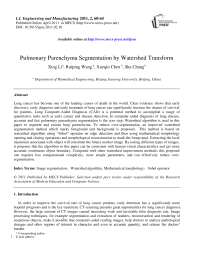Pulmonary Parenchyma Segmentation by Watershed Transform
Автор: Xing Li, Ruiping Wang, Xueqin Chen, Sha Chang
Журнал: International Journal of Engineering and Manufacturing(IJEM) @ijem
Статья в выпуске: 2 vol.1, 2011 года.
Бесплатный доступ
Lung cancer has become one of the leading causes of death in the world. Clear evidence shows that early discovery, early diagnosis and early treatment of lung cancer can significantly increase the chance of survival for patients. Lung Computer-Aided Diagnosis (CAD) is a potential method to accomplish a range of quantitative tasks such as early cancer and disease detection, In computer-aided diagnosis of lung disease, accurate and fast pulmonary parenchyma segmentation is the core step. Watershed algorithm is used in this paper to segment and extract lung parenchyma. To reduce over-segmentation, an improved watershed segmentation method which marks foreground and background is proposed. This method is based on watershed algorithm using “Sobel” operator on edge detection and then using mathematical morphology opening and closing operations and morphological reconstruction to mark the foreground. Extracting the local maximum associated with object will constitute the binary marker image. By testing different types of images, it proposes that the algorithm in this paper can be consistent with human visual characteristics and get more accurate, continuous object boundary. Compared with other watershed improvement methods, this proposed one requires less computational complexity, more simple parameters, and can effectively reduce over-segmentation.
Image segmentation,Watershed algorithm, Mathematical morphology,Sobel operator
Короткий адрес: https://sciup.org/15014123
IDR: 15014123
Список литературы Pulmonary Parenchyma Segmentation by Watershed Transform
- E.M. van Rikxoort, M. Prokop, B. de Hoop, M.A. Viergever, J.P.W. Pluim, and B. van Ginneken, “Automatic segmentation of the pulmonary lobes from fissures, airways, and lung borders: evaluation of robustness against missing data,” in MICCAI, 2009, pp. 263–271.
- L. Zhang, E. A. Hoffman, and J. M. Reinhardt, “Atlasdriven lung lobe segmentation in volumetric X-ray CT images,” IEEE Trans Med Imaging, vol. 25, no. 1, pp.1–16, 2006.
- E. M. van Rikxoort, B. de Hoop, S. van de Vorst, M. Prokop, and B. van Ginneken, “Automatic segmentation of pulmonary segments from volumetric chest CT scans.,” IEEE Trans Med Imaging, vol. 28, no. 4, pp. 621–630, 2009.
- J. C. Ross, R. San Jose Estepar, A. D´ıaz, C.-F. Westin, R. Kikinis, E. K. Silverman, and G. R. Washko, “Lung extraction, lobe segmentation and hierarchical region assessment for quantitative analysis on high resolution computed tomography images,” in MICCAI, 2009, pp.690–698.
- J. Wang, M. Betke, and J. P. Ko, “Pulmonary fissure segmentation on CT,” Medical Image Analysis, vol. 10, no. 4, pp. 530 – 547, 2006.
- H.P.Ng, S.H.ong, K.W.C.Foong, P.S.Goh, and W.L.Nowinski, “Medical image segmentation using K-means clustering and improver watershed algorithm,” in Proc. IEEE Southwest Symposium on Image Analysis and Interpretation, pp.61-65, 2006.
- V. Grau, A. U. J. Mewes, M. Alcañiz, R. Kikinis and S. K. Warfield, “Improved Watershed Transform for Medical Image Segmentation Using Prior Information”, IEEE Transactions on Medical Imaging, Vol. 23, No. 4, April 2004
- W. A. Kalender, H. Fichte, W. Bautz and M. Skalej, “Semiautomatic evaluation procedures for quantitative CT of the lung.” J Comput Assist Tomogr Vol.: 15 pp: 248-255, 1991.
- Computer assisted Diagnosis for Lung Cancer Screening: http://www.cvio.ioiiisvilie.edu.
- J. B. T. M. Roerdink and A. Meijster, “The watershed transform: Definitions, algorithms and parallelization strategies,” Fundamenta Informaticae, vol. 41, pp. 187–228, 2001.
- A. N. Moga and M. Gabbouj, “Parallel marker-based image segmentation with watershed transformation”, Journal of Parallel and Distributed Computing 51, 27{45}, 1, 1998
- E. A. Hoffman and G. McLennan, “Assessment of the pulmonary structure-function relationship and clinical outcomes measures: Quantitative volumetric CT of the lung,” Academic Radiol., vol. 4, no. 11, pp. 758–776, 1997.
- L. W. Hedlund, R. F. Anderson, P. L. Goulding, J. W. Beck, E. L. Effmann, and C. E. Putman, “Two methods for isolating the lung area of a CT scan for density information,” Radiology, vol. 144, pp. 353–357,1982.
- S. G. Armato III and W. F. Sensakovic, “Automated Lung Segmentation for Thoracic CT: Impact on Computer-Aided Diagnosis”Academic Radiology: Vol.11, No. 9, pp. 1011-1021, September 2004.
- M. S. Brown, M. F. Mcnittgray, N. J. Mankovich, J. G. Goldin, J. Hiller, L. S. Wilson and D.R. Aberle, “Method for segmenting chest CT image data using an anatomical model – preliminary results”, IEEE Trans Med Imaging. Vol. 16, pp. 828-839, Dec.1997.
- L. Vincent and P. Soille, “Watersheds in digital spaces: An efficient algorithm based on immersion simulations.” IEEE Trans.Patt.Anal.Mach.Int. 13(6), pp. 583–598, June 1991.
- K. Haris, S. N. Efstratiadis, N. Maglaveras, and A. K. Katsaggelos, “Hybrid image segmentation using watersheds and fast region merging,” IEEE Trans. Image Processing, vol. 7, No. 12, pp.1684-1699, Dec. 1998.


